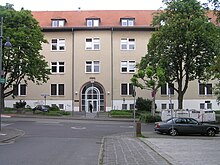Holex
| Holex-Schokoladenwerke AG | |
|---|---|
| legal form | AG |
| founding | 1894 as the Taunus chocolate and canning factory |
| resolution | 1933 |
| Reason for dissolution | insolvency |
| Seat | Bad Homburg , Germany |
| management | Paul Jungblut Phillipp Born |
| Number of employees | 500 |
| Philipp Born GmbH Chocolate Factory and Food | |
|---|---|
| legal form | GmbH |
| founding | 1929 |
| Seat | Friedrichsdorf , Germany |
| management | Hüseyin alkane |
| As of December 31, 2015 | |
Holex is the name of a chocolate that goes back to Holex-Schokoladenwerke AG Bad Homburg , which was founded in 1894 . Today diet chocolate is produced and sold under the brand name Holex by the Philipp Born chocolate factory, which belongs to Frankonia Schokoladenwerke GmbH, in the Seulberg district of Friedrichsdorf .
history
In 1876, the confectioner Franz Stroh built a sugar factory at Gluckensteinweg 5 in Homburg , which in 1894 became the property of Wilhelm Spies, who started producing chocolate in addition to canned fruit there under the new name Chocoladen- und Conservenfabrik Taunus . In addition to block chocolate , cocoa powder , coated tablets and chocolate cigarettes , the first milk chocolate was also produced by adding one liter of milk to one hundred kilos of chocolate mass. The deliveries went to the region as far as Limburg an der Lahn . From 1906 berry bushes and fruit trees were planted directly behind the house and the production of freshly harvested jams and preserves was introduced. For this purpose, extensions and a second chimney were built. When Wilhelm Spies left because of bankruptcy in 1913, director Paul Jungblut took over the company with 60 employees and from then on sold his products under the brand name Holex . In the following years, the company was modernized by purchasing new, electrically operated machines.
After the First World War , the unprofitable jam and canned food production was discontinued and the company was converted into a stock corporation under the new name Holex-Schokoladenwerke AG Bad Homburg . Increasing demand promoted growth and expansion during the Weimar Republic . At the Gluckensteinweg location, only raw chocolate was produced and packaging, storage and shipping were outsourced to rented rooms in the barracks at Kaiser-Friedrich-Promenade 10. Paul Jungblut died of a stroke on January 11, 1926 at the age of 48 in Bad Homburg's town hall. Up to 500 people were employed at that time, the majority of them women. From 1928 financial difficulties arose due to the global economic crisis and as a result, bankruptcy in 1929 .
The previous technical operations manager Philipp Born, who had claims against his employer, took over larger quantities of semi-finished products and the brand names from the bankruptcy estate as compensation. On April 14, 1929, he founded the Philipp Born chocolate factory and in 1930 set up his own chocolate factory at Wiesenbornstrasse 3 in order to continue to produce and sell Holex chocolate. Newly developed products especially for spa operations , such as Born's diet chocolate , expanded the range. The bankruptcy proceedings of Holex-Schokoladenwerke AG ended in 1933. The old chocolate factory in Glucksteinweg was demolished from 1932 until the chimney fell in 1934.
After completing his degree in business administration at the Johann Wolfgang Goethe University in Frankfurt am Main , Wilhelm (Willi) Born joined his father's company in 1936.
At the beginning of the 1950s the factory was rebuilt and the production of chocolate and pralines for diabetics under the Holex brand was resumed. From July 1, 1972, the Philipp Born chocolate factory was located in the Friedrichsdorf district of Seulberg after relocating . On November 9th, 1978 the company Philipp Born GmbH was founded chocolate factory and food . In 1989 Philipp Born GmbH was taken over by Frankonia Schokoladenwerke GmbH in Veitshöchheim, which was established in Würzburg as a chocolate factory in 1869 .
Individual evidence
- ↑ Philipp Born chocolate factory at Moneyhouse
- ↑ Annual financial statements in the Federal Gazette
- ↑ a b c d Only rubble where chocolate was once made . In: Frankfurter Neue Presse . No. 99/03 , p. 1 .
- ↑ Manuela Reimer: History to touch. In: Taunus Zeitung. December 2, 2011, accessed October 23, 2016 .
- ↑ Holex director dies in Bad Homburg town hall . In: Frankfurter Neue Presse . No. 99/12 , p. 27 .
- ↑ a b Friedrich Lotz, Heinz Grosche: History of the city of Bad Homburg before the height: Three difficult decades, 1918-1948 . Krämer, 1972, ISBN 978-3-7829-0436-0 , pp. 449 . Excerpt from Google Books
- ↑ Gerta Walsh: Noodles, chocolate and the Homburg hat. (PDF) In: Bad Homburg Week, week 34, page 3. Hochtaunus Verlag, August 25, 2016, accessed on October 3, 2016 .
- ^ Barbara Dölemeyer: History of the city of Bad Homburg in front of the height: departure, tradition, growth, 1948-1990 . Krämer, 2007, ISBN 978-3-7973-1048-4 , pp. 247 . Excerpt from Google Books
- ↑ Stefanie Michel: Wilhelm Born could serenade himself . In: Frankfurter Neue Presse . September 5, 1997, p. 3 (report on the 85th birthday).
- ^ Sybille Grübel: Timeline of the history of the city from 1814-2006. In: Ulrich Wagner (Hrsg.): History of the city of Würzburg. 4 volumes, Volume I-III / 2, Theiss, Stuttgart 2001-2007; III / 1–2: From the transition to Bavaria to the 21st century. Volume 2, 2007, ISBN 978-3-8062-1478-9 , pp. 1225-1247; here: p. 1231.
- ↑ Frankonia - a success story. Frankonia Schokoladenwerke GmbH, accessed on October 3, 2016 .
